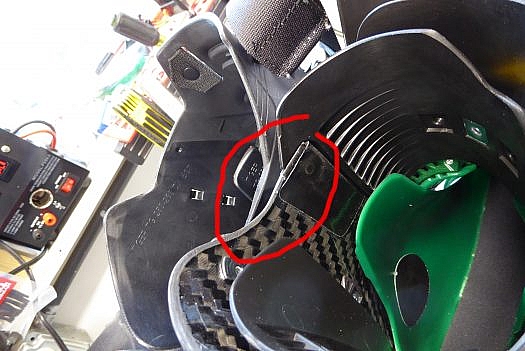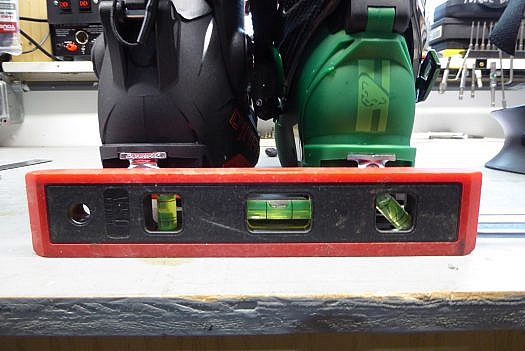You guys were asking, thought I’d do more bench touring seeming as it’s 82 degrees outside.
Vulcan and Hoji geometry are clearly more similar than different. Not clones. Kind of like comparing your feet to those of your sibling. DNA and all that sort of thing. Vulcan can be had for a song, discounted all over the place (including by our post sponsor Cripple Creek Backcountry). So why buy the Hoji Pro Tour instead of Vulcan? Glean a few reasons below.
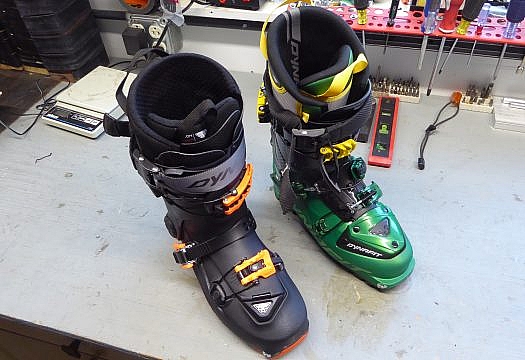
The objects at hand. Vulcan to right, spankin’ new Hoji to left. It is common knowledge that the Hoji designer’s point of departure was the Vulcan. So, it is asked, what’s different?
In my view, the over arching item is the “Hoji Lock” cuff lock system boasted by the Hoji Pro ski touring boot. Benefits: Probably a true “one motion” touring/downhill lock, but more importantly, stiff yet progressive flex in downhill mode, with minimal to no bulging when you drive your knees forward. Read on for additional comparison details.
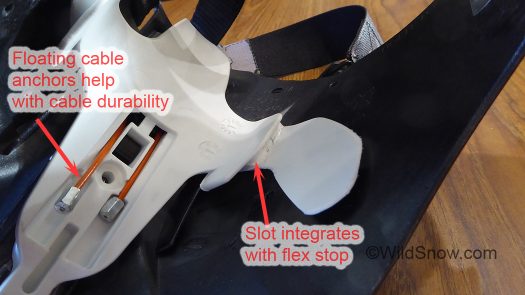
Demonstration boot white plastic does good job of showing the Hoji Lock cuff stop slots. This is an evolution of the Vulcan cuff stops.
With Vulcan fore-aft cuff angle set to what they call “15” degrees, I compared to Hoji using an angle gauge off the footboard. While Hoji is specified as “11” I could not discern any significant difference. Perhaps the Hoji liner is slightly thinner at the calf, that would drop you back a few degrees. Takeaway, by adding or subtracting material behind your leg, you could easily tune these boots for identical cuff lean angle. That is if they’re not there already.
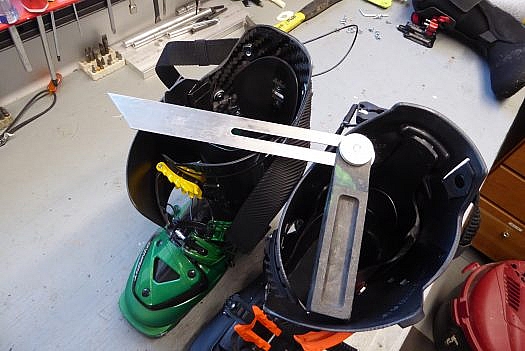
I’ve never been certain as to how the industry measures cuff angles. Who really cares? To keep it clear, I measure with an angle gauge using the interior boot board as base line, and average out the heel cup and spoiler. In many years of experience, this method gives a “real world” idea of how one boot will feel in comparison to another.
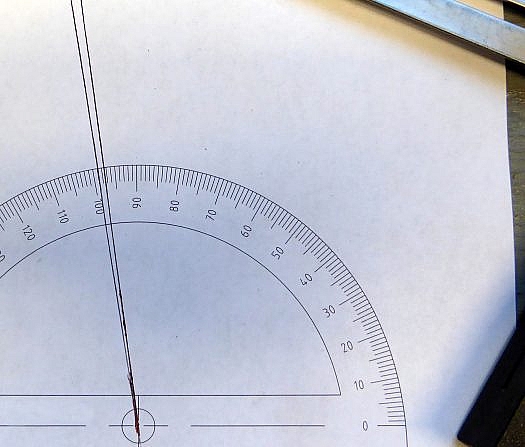
Interior cuff angles plotted, right ray is Vulcan at 7.5, left is Hoji at 9. Vulcan has slightly adjustable forward cuff lean, for this measurement it was set to relaxed angle, if set to steeper angle it would end about a degree steeper than Hoji. Such variations are easily tuned by adding or subtracting material behind your calf at the rear of the liner cuff, or just molding the liner more aggressively.
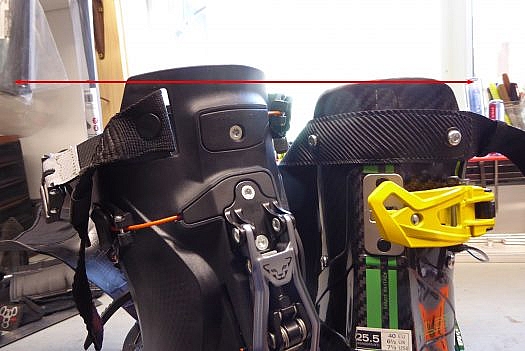
Hoji cuff taller at rear, to the extent you might notice it, but not a critical difference in my view.
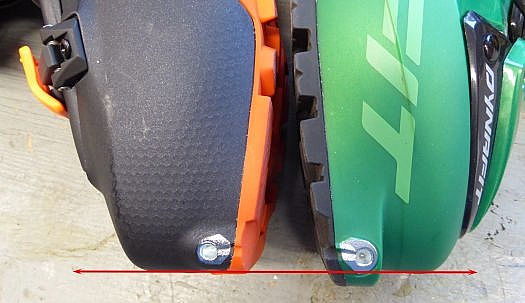
Controversial Speed Nose of the Hoji. We give this a 50/50 chance of making it as a success in sales, most important effect is the tech fitting is located about 3 millimeters farther to the rear than most other ski touring boots. This causes a slightly better more ergonomic touring stride, due to the binding-boot pivot being located closer to the ball of your foot. How much difference does this make in real life? I’ve always like the effect. How much faster it got me up the hill is probably insignificant. As we’ve been covering in other posts and the comments, the Speed Nose has issues with binding compatibility.
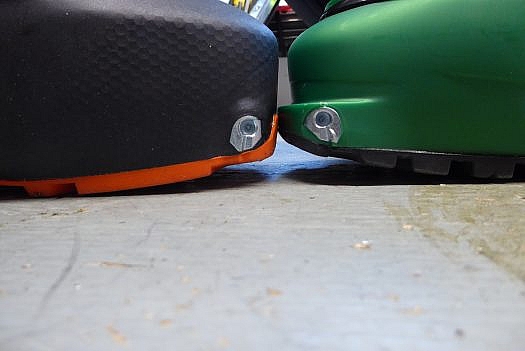
Vulcan (R) has a bit more rocker at the toe, with tech fittings a 1.5 mm higher. This might result in the Vulcan having a bit more forward delta (heel higher than toe), but the amount of that effect depends on the actual interior sole shape and thickness at the ball of your foot, as well as use of insoles. At these small amounts, easy to tune with basic boot fitting techniques.

Moving on to what’s important (ha). Ski touring boot last width. Comparing width measured at exterior, Vulcan shell appears to be about 3 mm narrower at the metatarsal.
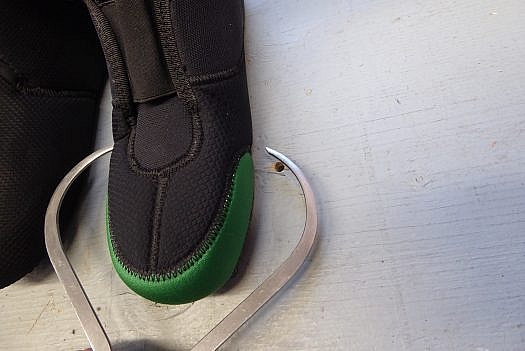
A better way of comparing last width is to measure the “ghost molded” stock liner width. Vulcan pictured here showed what I measured as fully 4 mm narrower than the Hoji liner. My research indicates the Vulcan last width is “103 mm” while the Hoji is “103.5,” I’d disagree with that, the Hoji clearly provides significantly more space at the ball of the foot. You can see it, and you can feel it if you do a shell fit. Now, for those of you who like tight boots, can the Hoji liner fill up this space adequately? In my opinion, probably. But that depends on the density of the liner foam — or the skills of your boot fitter. Main point for us here at WildSnow, Hoji is clearly a warmer boot.
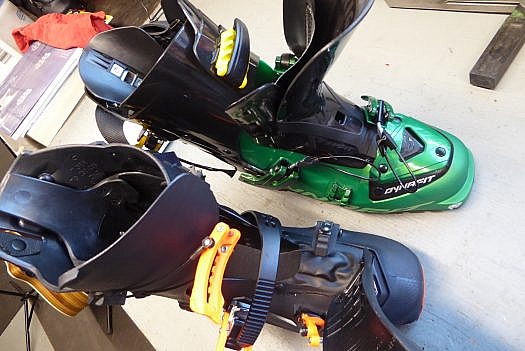
Both boots are not exactly pleasant to put on and take off. But once you’re buckled in, it appears the Hoji lock can indeed provide the relaxing “pants down always” one-motion locking feature. Easy to carpet test for yourself. Note that Vulcan requires its removable tongue to achieve uber stiffness, an added hassle that is never appreciated, thankfully not something you need with the Hoji.
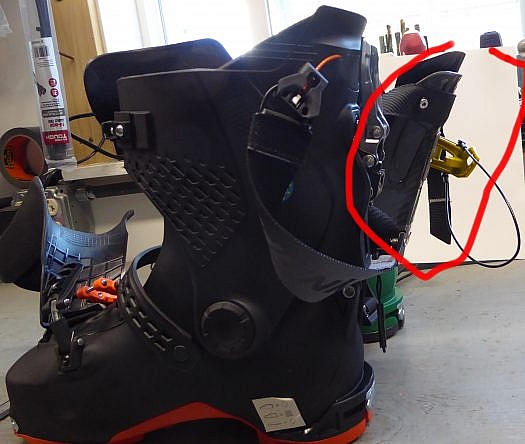
Some of you who actually ski tour (smile) might inquire of rearward cuff mobility. In my opinion, the Hoji is below average in that regard, for a ski touring boot. Hoji in front of photo, above, with Vulcan behind, both flexing rearward. They’re specified as 55 and 60 degrees “rotation,” respectively. While again who knows exactly how some guy in Montebelluna actually measures “rotation,” I’d just call it as the Vulcan having full movement range in touring mode, while the Hoji is limited in comparison, though still functional and better than certain competitors in the same “beef boot” space.
One other thing: Vulcan has user removable cuff stops, which combined with the Dynafit Ultralock cuff lock do major fusing of cuff to lower shell. Hoji Lock clearly evolved from this, only it eliminates the up/down locking action of the Ultralock in lieu of a rear lean lock that only resists rearward movement, with the forward “lockage” taken care of by the advanced technology cuff locks of the Hoji Lock.
Weights (per single boot) because I know you’ll ask:
25.5 Hoji, 1346 grams — shell no liner 1134 g
25.5 Vulcan, 1448 g (with removable tongue) — shell no liner 1220 g
I found it interesting the Vulcan 25,5 shell clocked in as 86 grams/3 ounces heavier than Hoji, as that’s near the exact weight of the removable tongue.
27.5 Hoji, 1478 grams
27.5 Vulcan, 1590 grams (with removable tongue)
Sole lengths:
Hoji 27.5 vs Dynafit TLT6 in 27.5, TLT specified as BSL 297, Hoji 301. When measured on bench, the distance from Hoji toe tech fitting to heel fitting is ~3mm longer than TLT.
BSLs of our Vulcan 25.5 and Hoji 25.5, 284 and 281, respectively, which goes right along with the Hoji toe tech fittings being located about 3 mm back from those of the Vulcan, due to the Hoji Speed Nose.
Conclusion: If you’re thinking of making your Darwinian path that of Hoji from Vulcan, you’ll be able to configure Hoji with ski touring ergonomics you’re familiar with. Only remember to do a side-by-side carpet test with one model on your right foot and one on the left (both with liner and without). And if you’re a stickler, do the carpet test while clipped into a pair of skis. You’ll probably discover you’re good to go. If not, your mods will likely be minimal.
WildSnow.com publisher emeritus and founder Lou (Louis Dawson) has a 50+ years career in climbing, backcountry skiing and ski mountaineering. He was the first person in history to ski down all 54 Colorado 14,000-foot peaks, has authored numerous books about about backcountry skiing, and has skied from the summit of Denali in Alaska, North America’s highest mountain.

